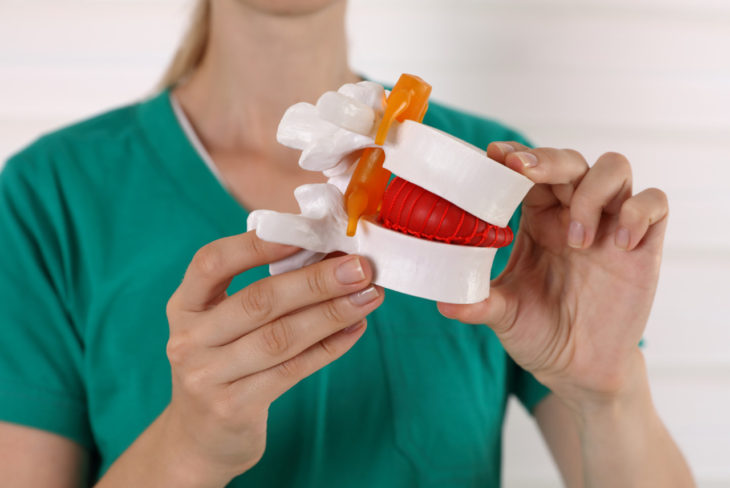
Top Five Signs That You May Have A Herniated Disc
If you’ve experienced back or neck pain, you may wonder if it is more than a pulled muscle and may be due to a herniated disc. The spine has 23 discs – one located between each of the vertebrae that run from the neck to the lower back. These discs provide cushioning and allow for movement in the spine. The discs are similar in structure to a donut. The outside edge is firm and composed of fibers while the inside has a squishy center. If the fibrous outer edge is injured or torn it allows the squishy center to bulge or rupture and the disc fluid can leak out. When that happens, it can create inflammation or pain at the site, especially if it presses on a nearby nerve.
Natural aging is a common cause of herniated discs, however a traumatic injury can also be the cause. Whiplash, falls and compression injuries can all be risk factors for a disc herniation. Other times, there may not be any specific event that it can be traced back to. Some of the common signs that your back or neck pain may be more than a pulled or strained muscle include:
- Sharp pain in the back or neck
Sharp or excruciating pain in the back or neck may be the sign of a disc herniation. When a disc ruptures it can press on a nerve and cause severe, sharp pain. It may also create an inflammatory response that causes the nearby muscles to tighten and spasm, which is painful and can limit motion. Most times, once the inflammation is reduced the disc pain feels better and the muscles settle down.
- Pain that gets worse with bending forward or sitting down
With a herniated disc, a lot of times it may be aggravated by bending forward or sitting down. Coughing, sneezing or quick movements can also increase the severity of the pain. It is not uncommon for individuals to have balance problems or difficulty walking when they have a herniated disc. Often times, laying down can help to unload the pressure on the disc can make it feel better.
- Radiating pain in the arm or leg
A herniated disc my cause pain that radiates into other areas of the body. If the herniation is in the neck, individuals may experience pain in the shoulder or down the arm and even into the hand and fingers. A herniated disc in the back can cause pain that radiates into the leg. Sometimes this radiating pain can interfere with or limit normal daily activities.
- Numbness or tingling in the arm or leg
If a disc is pressing on a nerve, individuals may also experience numbness or tingling in the leg or arm. This happens when there is nerve impingement in the neck or the back. This can also lead to weakness in the arm, leg or even foot. Any muscle weakness is a sign to seek evaluation and treatment from a doctor right away. If people experience back pain without leg or arm symptoms – it could still be a herniated disc – it just means its not pressing on a nerve or causing inflammation around a nerve.
- You may have no symptoms at all
Herniated discs are common and many people don’t even know that they have one.
Studies have shown that between 20 – 50% of people with herniated discs do not have any pain, and as you age, that number goes up. For individuals over sixty years old, up to 80% may have disc problems without any associated pain. The short story here – not all herniated discs are painful.
Relieving the pain of a herniated disc
The good news is that most herniated discs do not require surgery and fortunately there are many options for treatment that can reduce or alleviate the pain. Most people get better with physical therapy and over-the-counter anti-inflammatory medications, but when conservative treatment is not effective your doctor has many options for pain relief.
Treatments are aimed at reducing inflammation or treating nerve symptoms to alleviate pain. To reduce inflammation your doctor may recommend a short course of oral steroid or possibly an epidural steroid injection into the area surrounding the disc. Depending on your individual symptoms, your doctor may also prescribe medications to reduce the pain. These may include muscle relaxers to relieve muscle spasms or nerve medication to help if the disc is pressing on a nerve. While your doctor can help relieve pain and you ultimately feel better, it’s important to note that these treatments do not inherently “fix” the disc.
When conservative treatments are not effective at relieving your pain, or if you are experiencing any muscle weakness your doctor may order an MRI to confirm a suspected diagnosis of a herniated disc. Muscle weakness or pain that doesn’t get better are indications that surgical intervention may be necessary.
In 90% of cases, conventional pain management techniques are enough to relieve the pain of a herniated or ruptured disc. Physical therapy, good posture, improving core strength and utilizing proper lifting techniques are the best way to alleviate back pain altogether and keep people moving and feeling good.
Dr. E Taylor Abel is a physical medicine and rehabilitation specialist at Panorama Orthopedics & Spine Center. Trained at the highly- acclaimed Bodor Clinic, he helps people with orthopedic pain in the hips, knees, shoulders, back or neck. His offices are located in South Denver in Greenwood Village and Centennial.